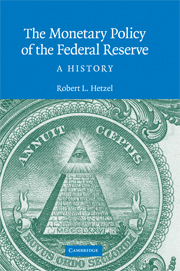Book contents
- Frontmatter
- Contents
- Figures
- Preface
- 1 The Pragmatic Evolution of the Monetary Standard
- 2 Learning and Policy Ambiguity
- 3 From Gold to Fiat Money
- 4 From World War II to the Accord
- 5 Martin and Lean-against-the-Wind
- 6 Inflation Is a Nonmonetary Phenomenon
- 7 The Start of the Great Inflation
- 8 Arthur Burns and Richard Nixon
- 9 Bretton Woods
- 10 Policy in the Ford Administration
- 11 Carter, Burns, and Miller
- 12 The Political Economy of Inflation
- 13 The Volcker Disinflation
- 14 Monetary Policy after the Disinflation
- 15 Greenspan's Move to Price Stability
- 16 International Bailouts and Moral Hazard
- 17 Monetary Policy Becomes Expansionary
- 18 Departing from the Standard Procedures
- 19 Boom and Bust: 1997 to 2001
- 20 Backing Off from Price Stability
- 21 The Volcker–Greenspan Regime
- 22 The Fed: Inflation Fighter or Inflation Creator?
- 23 The Stop–Go Laboratory
- 24 Stop–Go and Interest Rate Inertia
- 25 Monetary Nonneutrality in the Stop–Go Era
- 26 A Century of Monetary Experiments
- Appendix: Data Seen by FOMC for the Stop–Go Period Shown in Figures 24.1, 24.2, and 24.3
- Notes
- Bibliography
- Index
- Titles in the series
26 - A Century of Monetary Experiments
Published online by Cambridge University Press: 26 May 2010
- Frontmatter
- Contents
- Figures
- Preface
- 1 The Pragmatic Evolution of the Monetary Standard
- 2 Learning and Policy Ambiguity
- 3 From Gold to Fiat Money
- 4 From World War II to the Accord
- 5 Martin and Lean-against-the-Wind
- 6 Inflation Is a Nonmonetary Phenomenon
- 7 The Start of the Great Inflation
- 8 Arthur Burns and Richard Nixon
- 9 Bretton Woods
- 10 Policy in the Ford Administration
- 11 Carter, Burns, and Miller
- 12 The Political Economy of Inflation
- 13 The Volcker Disinflation
- 14 Monetary Policy after the Disinflation
- 15 Greenspan's Move to Price Stability
- 16 International Bailouts and Moral Hazard
- 17 Monetary Policy Becomes Expansionary
- 18 Departing from the Standard Procedures
- 19 Boom and Bust: 1997 to 2001
- 20 Backing Off from Price Stability
- 21 The Volcker–Greenspan Regime
- 22 The Fed: Inflation Fighter or Inflation Creator?
- 23 The Stop–Go Laboratory
- 24 Stop–Go and Interest Rate Inertia
- 25 Monetary Nonneutrality in the Stop–Go Era
- 26 A Century of Monetary Experiments
- Appendix: Data Seen by FOMC for the Stop–Go Period Shown in Figures 24.1, 24.2, and 24.3
- Notes
- Bibliography
- Index
- Titles in the series
Summary
Deflation or inflation prevailed during most of the 65 years following the establishment of the Fed. Instability in the real economy accompanied monetary instability. In contrast, starting after the Volcker disinflation, low, stable inflation accompanied considerable real stability. An understanding of these outcomes requires a combination of knowledge about the way that monetary policy evolved and of theory. The evolution of monetary policy reflects an increased assumption over time by the Fed of a responsibility for actual and expected inflation. The theory assumes that actual and expected inflation are monetary phenomena shaped by the systematic part of central bank procedures. Also, in the absence of central bank behavior that makes the price level evolve unpredictably, the price system works well to maintain macroeconomic equilibrium.
Three lessons emerge: (1) Inflation is a monetary phenomenon whose behavior is determined by the central bank. (2) Central bank credibility evidenced by stability in expected inflation is central to inflation stability. (3) The central bank must allow the price system to work. These lessons provide the foundation for understanding monetary policy in the V–G era as rule-like behavior that disciplined the lean-against-the-wind character of funds rate changes to ensure that macroeconomic shocks left actual and expected trend inflation unchanged.
A Nominal Anchor Lost and Regained
For the founders of the Fed, who took the gold standard for granted without understanding it, the marketplace determined the price level.
- Type
- Chapter
- Information
- The Monetary Policy of the Federal ReserveA History, pp. 311 - 318Publisher: Cambridge University PressPrint publication year: 2008

